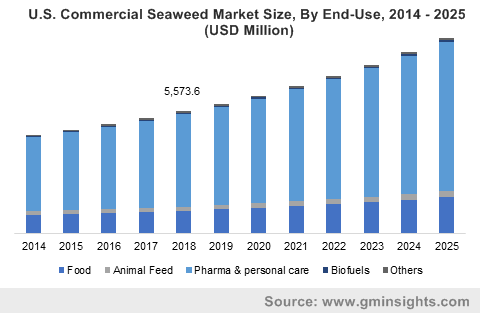A succinct outline of the global commercial seaweed market trends: research and development undertakings to expedite industry advancement over 2017-2024
Publisher : Fractovia | Published Date : 2018-03-22Request Sample
The recent production capability augmentation drive of CP Kelco has generated a rather considerable anticipation across commercial seaweed market. The US based hydrocolloid solutions manufacturer has apparently concluded its Kelcogel gellan gum production competency revamp at its Oklahoma plant. Apparently, these processed seaweeds in the form of hydrocolloids have found extensive applications across the swiftly expanding food industry. It would be prudent to mention that hydrocolloids are being increasingly utilized as food additives in dairy, meat & poultry processing, desserts & jelly, and canned fish.
U.S. Commercial Seaweed Market Size, by End-Users, 2013 - 2024 (USD Million)

Consequentially, the growing instances of major market players focusing on enhancing manufacturing capacities has emerged as one of the most pivotal factors to have propelled the commercial seaweed industry size expansion in the recent years. In fact, as per a research report compiled by Global Market Insights, Inc., the market share of this fast-evolving and noteworthy niche vertical of food, nutrition, and animal feed industry was claimed to be a staggering USD 45 billion in 2016.
Research and development endeavors to impact the commercial seaweed industry growth trends
Apart from making rapid headways in the food industry, seaweed products have found widespread acceptance across various other business sectors as well. Textile printing, waste water treatment, biofuel production, pharmaceutical & medical, paper & pulp, pet food, and other industry verticals have cropped up as prominent end-user sectors of commercial seaweed industry.
It goes without mentioning that the persistent research activities being undertaken by commercial seaweed market players have aided in speedy product penetration. Enlisted below are a few instances that demonstrate the growing influence of research and development ventures that aim to bring about massive altercations across commercial seaweed industry space:
- It has to be noted that seaweed products are being utilized as plant growth stimulants in the agricultural fields and have acquired a significant place in overall plant nutrition. Reportedly, numerous farmers across the US have been incorporating seaweed extracts in fertility programs to bolster farm yields. Apparently, scientists across major universities in the US have been conducting comprehensive studies to find the exact benefits of seaweeds. For instance, agricultural researchers of University of California Co-operative Extension have scarcely revealed that a seaweed extract, ascophyllum nodosum, could assist in mitigating the ill-effects of cold temperature, osmotic stress, drought, and high salinity in the soil while growing almonds and pistachios. Concurrently, further studies are likely to pinpoint the growth promoting characteristics of seaweed extracts, which would undoubtedly provide a significant boost to commercial seaweed market share augmentation.
- With an aim to predominantly transform the commercial seaweed industry landscape, a team of researchers from Oregon State University have reportedly cultivated a new seaweed, a form of red marine algae. It is being said that the unique seaweed grows speedily and has twice the nutritional value of kale. The new strain, which primarily grows along Atlantic and Pacific coastlines, was discovered by researchers while they were attempting to find a suitable alternative to edible sea snails. Moreover, the scientists have successfully created a range of foods, in collaboration with Food Innovation Center of University, with seaweed as the chief ingredient.
- One of the foremost concerns of the global shipping industry has been biofouling which is nothing but the formation of algae, mollusks, and barnacles on the hull of ships. This increases the fuel consumption of marine vessels by up to 40% and further leads to enormous labor costs. Apparently, in order to lower the harmful consequences of biofouling, researchers from Bharathidasan University in Tiruchirappalli have reportedly tested ten different varieties of seaweed against biofilm-forming bacteria and barnacles. As per reliable reports, these seaweeds are more effective and eco-friendly than the existing anti-fouling agents which are known to be highly toxic in nature. Needless to mention, the commercial seaweed industry experts have been anticipating large scale application of these anti-corrosive seaweeds over the ensuing years.
Complementing the massive R&D activities across the globe, it has also been observed that the emergence of new extraction and processing technologies of seaweed-derived biofuels has impelled the growth potential of commercial seaweed market in the recent past. This is in addition to the rising demand of seaweed products across numerous end use segments including animal feed, fertilizer production, food and beverages, textile, and paper, which would further drive the commercial seaweed industry share expansion over the forecast time frame.